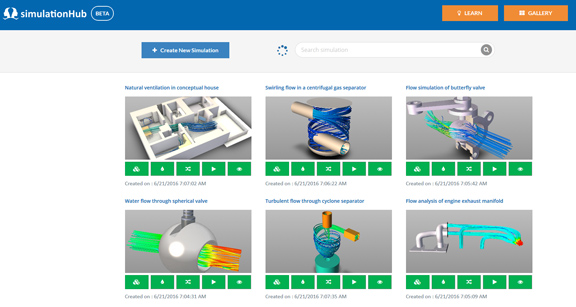Insights from ASSESS: Looking Beyond the Pay-as-You-Go Model for Simulation Democratization

Latest News
June 29, 2016
 The proliferation of simulation apps (shown here are examples from simulationHub) makes simulation software much more accessible among the novices. But it also demands new licensing models that make sense for the app builder, the general-purpose simulation technology vendor, and the app consumer.
The proliferation of simulation apps (shown here are examples from simulationHub) makes simulation software much more accessible among the novices. But it also demands new licensing models that make sense for the app builder, the general-purpose simulation technology vendor, and the app consumer.In the recent years, the CAD software business has gradually been shifting toward the subscription-based, pay-as-you-go model. A similar movement is also afoot in the simulation software market, a cousin of the CAD market.
But, based on discussions at the Analysis, Simulation and Systems Engineering Software Summit (ASSESS, January 20-22, Potomac, Maryland), Joe Walsh, CEO and founder of IntrinSIM, cautioned, “People overemphasize the pay-as-you-go model as the be-all and the end-all of licensing issues. But the reality is, it only works with light to moderate usage; it doesn’t work well with heavy usage.”
Light to moderate simulation software users could benefit from pay-as-you-go licensing, since it bypasses the significant investment to acquire the software. But heavy users who use simulation routinely are economically much better off with perpetual licenses, for the same reason those who use a vehicle daily would favor perpetual ownership over rental.
ASSESS is billed as a “multi-industry initiative that began with the goal to expand the use and benefit of software tools for model-based analysis, simulation, and systems engineering.” It’s organized by Cyon Research, the technology consultancy and analyst firm that also produces the annual Congress on the Future of Engineering Software (COFES).
One of the difficult puzzles to solve in the usage-based model is cost. Walsh pointed out, “With the pay-per-use model, you know the rate at which you’re paying for your consumption. But it’s difficult to tell ahead of time how much you’ll consume.”
The software-as-a-service (SaaS) model swept across the business and productivity market because users can predict with relative certainty how long it would take to finish a project in, say, Microsoft Office or Adobe Creative Suites. Not so with simulation software.
Walsh explained, “Running simulation is not just setting it up perfectly, running it once, and getting an answer. You might run it once, make design changes, and run it again. It might take one, three, or seven runs to get you an answer. And the mesh model in the second or third run may be much more refined, which influences how long it takes to get the answer. That’s why there are now several vendors looking at different models beside the consumption-based model.”
Pay-as-you-go simulation differs from the SaaS-style office and personal productivity software in one primary aspect—the need to add computing resources to the equation. With simulation jobs, the processing power you deploy (measured in CPU and GPU hours) affects the speed and accuracy of the task. Therefore, pay-as-you-go simulation vendors need to figure out a way to offer both software usage and processing power in an economically sensible bundle.
ASSESS participants also put to bed the debate about wider access to simulation, or computer-aided engineering (CAE). “We’ve gotten over that debate,” said Walsh. “We’ve accepted that democratization of simulation is inevitable. The discussions are no longer about whether to democratize or not. Now, we’re working out how to to do it.”
Some used to argue that giving more people access to simulation is ill-advised, because the software tools are meant for experts, not novices. But the current movement is to make software-based simulation easier to learn and use. Some use vertical apps (for example, a heat sink simulator app) as a way to reduce the learning curve; others try to introduce CAD-embedded simulation modules.
The introduction of apps also complicates licensing issues. Current simulation vendors market general-purpose simulation programs to end users. Apps usually run on top of a general purpose simulation program, as guided, template-driven tasks. A three-way licensing arrangement involving a general-purpose software vendor, the custom app developers, and the app consumers has never been considered.
Walsh said, “The good thing is, we no longer have to convince people that the current tools require too much expertise. This realization was the impetus for ASSESS.”
Simulation vendors are in a competitive race, but they also recognize they all stand to benefit from widespread adoption of simulation. Therefore, it’s in their own interest to make simulation easier to learn, use, and deploy.
Subscribe to our FREE magazine, FREE email newsletters or both!
Latest News
About the Author
Kenneth Wong is Digital Engineering’s resident blogger and senior editor. Email him at [email protected] or share your thoughts on this article at digitaleng.news/facebook.
Follow DERelated Topics






